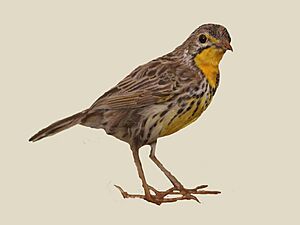Pangani longclaw facts for kids
Quick facts for kids Pangani longclaw |
|
|---|---|
 |
|
| Specimen at Nairobi National Museum | |
| Conservation status | |
| Scientific classification | |
| Genus: |
Macronyx
|
| Species: |
aurantiigula
|
The Pangani longclaw (Macronyx aurantiigula) is a cool bird that belongs to the Motacillidae family. This family also includes other well-known birds like pipits and wagtails. You can find the Pangani longclaw living in parts of Tanzania, Kenya, and Somalia. These birds love dry savanna areas and warm, dry grasslands in low-lying regions.
A German bird expert named Anton Reichenow first described this bird in 1891. The Pangani longclaw is part of a group of birds called Macronyx, which are all known as longclaws.
Contents
What's in a Name?
The name Macronyx comes from ancient Greek words. "Makros" means "long," and "onyx" means "claw" or "talons." This makes sense because these birds have noticeably long claws!
The second part of its scientific name, aurantiigula, comes from Latin words. "Aurantium" means "orange," and "gula" means "throat." So, its name literally means "long-clawed orange-throat," which is a perfect description of this bird!
Meet the Pangani Longclaw
What Does It Look Like?
The Pangani longclaw is about 20 centimeters (or 8 inches) long. That's about the length of a standard pencil! As its name suggests, it has a bright yellow-orange throat. This colorful throat is outlined by a neat black "necklace" band.
Its back and upper parts are a mix of different shades of brown, giving it a mottled, camouflaged look. Its belly is bright yellow. Young Pangani longclaws have a belly that's more of a dull yellow or buff color, and their dark chest band isn't as clear. The sides of their body have black and buff stripes. When it flies, it moves in a bouncy, jerky way.
What Does It Sound Like?
The Pangani longclaw has a special call. People describe it as a high-pitched siuuweeeee. The sound starts high, then drops a bit, then rises again before slowly fading away.
How to Tell It Apart
It can be a bit tricky to tell the Pangani longclaw apart from other similar birds like the yellow-throated longclaw or the Abyssinian longclaw. The Pangani longclaw's throat is usually more orange. However, female birds and older young birds might have a more yellow throat, which can be confusing! The Abyssinian longclaw also lives further north, in places like Ethiopia.
Where Does It Live?
The Pangani longclaw mostly lives on the ground. It prefers open grasslands and can be found at elevations up to 1,800 meters (about 5,500 feet) high.



